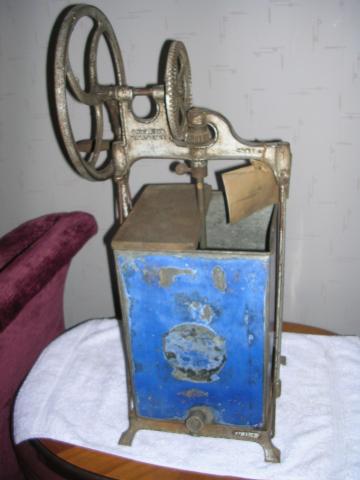This item is a butter churn pattented December 18, 1917. It was produced by the Dazey Churn & Mfg. Co. of St. Louis, Missouri. It is square and made of mostly steel, with blue embossing on one side and two flywheels situated on an arm above the box of the churn itself. The item was donated by Mr. Wayne Jensen, whose mother, Mrs. Clara Jensen, used it while living in St. Ansgar, Osage County, Iowa during the 20th century. Butter churns are devices that have a long history in the United States and the rest of the world. The essential purpose of manual butter churns is to separate cream into butter and buttermilk, after which it can be processed again into more refined dairy products. This works by spinning the cream in a container. The spinning motion breaks apart the membranes surrounding the milk fat in the cream. As the membranes break apart, the fat forms into butter and buttermilk. Over time, the butter churn became a staple of dairy production, and mechanized versions of the same principle are applied in the modern dairy industry. This content can be used with the following standards: SS 4.25: Technological Change SS 4.26: Agricultural Change Although butter churn technology has remained relatively unchanged in principle for over a millennia, the late 19th and early 20th centuries saw a development in the ways in which common tools of agricultural production were manufactured. The Industrial Revolution started a process by which tools like churns became mass-produced, rather than homemade. The increasingly standardized nature of many such tools is reflective of how both the agricultural landscape and the technology used in that landscape have evolved over time. For any use other than instructional resources, please check with the organization that owns this item for any copyright restrictions.
2018.018.143 [Churn]
Legal Status
Copyright to this resource is held by the Cedar Falls Historical Society and has been provided here for educational purposes only, specifically for use in the Iowa Museum Association's "Teaching Iowa History" project. It may not be downloaded, reproduced or distributed in any format without written permission from the Rights Holder. For more information on U.S. and International copyright laws, consult an attorney.

